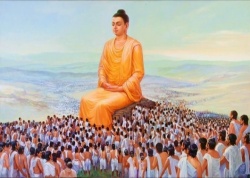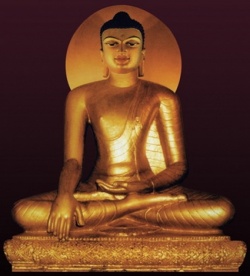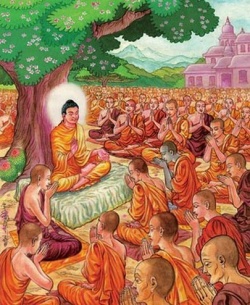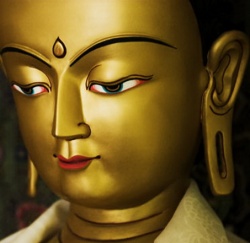Difference between revisions of "Anicca Vata Sankhar"
| Line 6: | Line 6: | ||
| − | [[Anicca]] [[vata]] [[sankhara]] — "[[Impermanent]], alas, are all [[formations]]!" — is the [[phrase]] used in [[Theravada]] [[Buddhist]] lands to announce the [[death]] of a loved one, but I have not quoted this line here in [[order]] to begin an obituary. I do so simply to introduce the [[subject]] of this essay, which is the [[word]] [[sankhara]] itself. Sometimes a single [[Pali]] [[word]] has such rich implications that merely to sit down and draw them out can shed as much [[light]] on the [[Buddha]]'s [[teaching]] as a long expository article. This is indeed the case with the [[word]] [[sankhara]]. The [[word]] stands squarely at the [[heart]] of the [[Dhamma]], and to trace its various [[strands]] of meaning is to get a glimpse into the [[Buddha]]'s own [[vision]] of [[reality]]. | + | [[Anicca]] [[vata]] [[sankhara]] — "[[Impermanent]], alas, are all [[formations]]!" — is the [[phrase]] used in [[Theravada]] [[Buddhist]] lands to announce the [[death]] of a loved one, but I have not quoted this line here in [[order]] to begin an obituary. I do so simply to introduce the [[subject]] of this essay, which is the [[word]] [[sankhara]] itself. Sometimes a single [[Pali]] [[word]] has such rich implications that merely to sit down and draw them out can shed as much [[light]] on the [[Buddha]]'s [[teaching]] as a long expository article. This is indeed the case with the [[word]] [[sankhara]]. The [[word]] stands squarely at the [[heart]] of the [[Dhamma]], and to trace its various [[strands]] of meaning is to get a glimpse into the [[Buddha]]'s [[own]] [[vision]] of [[reality]]. |
The [[word]] [[sankhara]] is derived from the prefix [[sam]], meaning "together," joined to the {{Wiki|noun}} [[kara]], "doing, making." [[Sankharas]] are thus "co-doings," things that act in concert with other things, or things that are made by a combination of other things. [[Translators]] have rendered the [[word]] in many different ways: [[formations]], confections, [[activities]], {{Wiki|processes}}, forces, compounds, compositions, [[fabrications]], [[determinations]], synergies, constructions. All are clumsy attempts to capture the meaning of a [[philosophical]] {{Wiki|concept}} for which we have no exact parallel, and thus all English renderings are [[bound]] to be imprecise. I myself use "[[formations]]" and "[[volitional]] [[formations]]," {{Wiki|aware}} this choice is as defective as any other. | The [[word]] [[sankhara]] is derived from the prefix [[sam]], meaning "together," joined to the {{Wiki|noun}} [[kara]], "doing, making." [[Sankharas]] are thus "co-doings," things that act in concert with other things, or things that are made by a combination of other things. [[Translators]] have rendered the [[word]] in many different ways: [[formations]], confections, [[activities]], {{Wiki|processes}}, forces, compounds, compositions, [[fabrications]], [[determinations]], synergies, constructions. All are clumsy attempts to capture the meaning of a [[philosophical]] {{Wiki|concept}} for which we have no exact parallel, and thus all English renderings are [[bound]] to be imprecise. I myself use "[[formations]]" and "[[volitional]] [[formations]]," {{Wiki|aware}} this choice is as defective as any other. | ||
| Line 14: | Line 14: | ||
The [[suttas]] distinguish the [[sankharas]] active in [[dependent origination]] into three types: [[bodily]], [[verbal]], and [[mental]]. Again, the [[sankharas]] are divided into the [[meritorious]], [[demeritorious]], and "imperturbable," i.e., the [[Wikipedia:Volition (psychology)|volitions]] {{Wiki|present}} in the four [[formless meditations]]. When [[ignorance]] and [[craving]] underlie our {{Wiki|stream}} of [[consciousness]], our [[volitional]] [[actions]] of [[body]], [[speech]], and [[mind]] become forces with the capacity to produce results, and of the results they produce the most significant is the renewal of the {{Wiki|stream}} of [[consciousness]] following [[death]]. It is the [[sankharas]], propped up by [[ignorance]] and fueled by [[craving]], that drive the {{Wiki|stream}} of [[consciousness]] onward to a new mode of [[rebirth]], and exactly where [[consciousness]] becomes established is determined by the [[kammic]] [[character]] of the [[sankharas]]. If one engages in [[meritorious]] [[deeds]], the [[sankharas]] or [[volitional]] [[formations]] will propel [[consciousness]] toward a [[happy]] [[sphere]] of [[rebirth]]. If one engages in [[demeritorious]] [[deeds]], the [[sankharas]] will propel [[consciousness]] toward a [[miserable]] [[rebirth]]. And if one [[masters]] the [[formless meditations]], these "imperturbable" [[sankharas]] will propel [[consciousness]] toward [[rebirth]] in the [[formless realms]]. | The [[suttas]] distinguish the [[sankharas]] active in [[dependent origination]] into three types: [[bodily]], [[verbal]], and [[mental]]. Again, the [[sankharas]] are divided into the [[meritorious]], [[demeritorious]], and "imperturbable," i.e., the [[Wikipedia:Volition (psychology)|volitions]] {{Wiki|present}} in the four [[formless meditations]]. When [[ignorance]] and [[craving]] underlie our {{Wiki|stream}} of [[consciousness]], our [[volitional]] [[actions]] of [[body]], [[speech]], and [[mind]] become forces with the capacity to produce results, and of the results they produce the most significant is the renewal of the {{Wiki|stream}} of [[consciousness]] following [[death]]. It is the [[sankharas]], propped up by [[ignorance]] and fueled by [[craving]], that drive the {{Wiki|stream}} of [[consciousness]] onward to a new mode of [[rebirth]], and exactly where [[consciousness]] becomes established is determined by the [[kammic]] [[character]] of the [[sankharas]]. If one engages in [[meritorious]] [[deeds]], the [[sankharas]] or [[volitional]] [[formations]] will propel [[consciousness]] toward a [[happy]] [[sphere]] of [[rebirth]]. If one engages in [[demeritorious]] [[deeds]], the [[sankharas]] will propel [[consciousness]] toward a [[miserable]] [[rebirth]]. And if one [[masters]] the [[formless meditations]], these "imperturbable" [[sankharas]] will propel [[consciousness]] toward [[rebirth]] in the [[formless realms]]. | ||
[[File:Bud24wing.jpg|thumb|250px|]] | [[File:Bud24wing.jpg|thumb|250px|]] | ||
| − | A second major domain where the [[word]] [[sankharas]] applies is among the [[five aggregates]]. The fourth [[aggregate]] is the [[sankhara]]-[[khandha]], the [[aggregate]] of [[volitional]] [[formations]]. The texts define the [[sankhara]]-[[khandha]] as the six classes of [[Wikipedia:Volition (psychology)|volition]] (cha cetanakaya): [[Wikipedia:Volition (psychology)|volition]] regarding [[forms]], {{Wiki|sounds}}, {{Wiki|smells}}, {{Wiki|tastes}}, {{Wiki|tactile}} [[objects]], and [[ideas]]. Though these [[sankharas]] correspond closely to those in the [[formula]] of [[dependent origination]], the two are not in all respects the same, for the [[sankhara-khandha]] has a wider range. The [[aggregate]] of [[volitional]] [[formations]] comprises all kinds of [[Wikipedia:Volition (psychology)|volition]]. It includes not merely those that are [[kammically]] potent, but also those that are [[kammic]] results and those that are [[kammically]] inoperative. In the later [[Pali literature]] the [[sankhara-khandha]] becomes an [[umbrella]] category for all the factors of [[mind]] except [[feeling]] and [[perception]], which are assigned to [[aggregates]] of their own. [[Thus]] the [[sankhara-khandha]] comes to include such [[ethically]] variable factors as [[contact]], [[attention]], [[thought]], and [[energy]]; such [[wholesome]] factors as [[generosity]], [[kindness]], and [[wisdom]]; and such [[unwholesome]] factors as [[greed]], [[hatred]], and [[delusion]]. Since all these factors arise in {{Wiki|conjunction}} with [[Wikipedia:Volition (psychology)|volition]] and participate in [[volitional]] [[activity]], the early [[Buddhist]] [[teachers]] decided that the most fitting place to assign them is the [[aggregate]] of [[volitional]] [[formations]]. | + | A second major domain where the [[word]] [[sankharas]] applies is among the [[five aggregates]]. The fourth [[aggregate]] is the [[sankhara]]-[[khandha]], the [[aggregate]] of [[volitional]] [[formations]]. The texts define the [[sankhara]]-[[khandha]] as the six classes of [[Wikipedia:Volition (psychology)|volition]] (cha cetanakaya): [[Wikipedia:Volition (psychology)|volition]] regarding [[forms]], {{Wiki|sounds}}, {{Wiki|smells}}, {{Wiki|tastes}}, {{Wiki|tactile}} [[objects]], and [[ideas]]. Though these [[sankharas]] correspond closely to those in the [[formula]] of [[dependent origination]], the two are not in all respects the same, for the [[sankhara-khandha]] has a wider range. The [[aggregate]] of [[volitional]] [[formations]] comprises all kinds of [[Wikipedia:Volition (psychology)|volition]]. It includes not merely those that are [[kammically]] potent, but also those that are [[kammic]] results and those that are [[kammically]] inoperative. In the later [[Pali literature]] the [[sankhara-khandha]] becomes an [[umbrella]] category for all the factors of [[mind]] except [[feeling]] and [[perception]], which are assigned to [[aggregates]] of their [[own]]. [[Thus]] the [[sankhara-khandha]] comes to include such [[ethically]] variable factors as [[contact]], [[attention]], [[thought]], and [[energy]]; such [[wholesome]] factors as [[generosity]], [[kindness]], and [[wisdom]]; and such [[unwholesome]] factors as [[greed]], [[hatred]], and [[delusion]]. Since all these factors arise in {{Wiki|conjunction}} with [[Wikipedia:Volition (psychology)|volition]] and participate in [[volitional]] [[activity]], the early [[Buddhist]] [[teachers]] decided that the most fitting place to assign them is the [[aggregate]] of [[volitional]] [[formations]]. |
[[File:Budd4274ha-pc.jpg|thumb|250px|]] | [[File:Budd4274ha-pc.jpg|thumb|250px|]] | ||
The third major domain in which the [[word]] [[sankhara]] occurs is as a designation for all [[conditioned things]]. In this context the [[word]] has a passive derivation, denoting whatever is formed by a combination of [[conditions]]; whatever is [[conditioned]], [[constructed]], or [[compounded]]. In this [[sense]] it might be rendered simply "[[formations]]," without the qualifying {{Wiki|adjective}}. As bare [[formations]], [[sankharas]] include all [[five aggregates]], not just the fourth. The term also includes {{Wiki|external}} [[objects]] and situations such as [[mountains]], fields, and forests; towns and cities; [[food]] and drink; jewelry, cars, and computers. | The third major domain in which the [[word]] [[sankhara]] occurs is as a designation for all [[conditioned things]]. In this context the [[word]] has a passive derivation, denoting whatever is formed by a combination of [[conditions]]; whatever is [[conditioned]], [[constructed]], or [[compounded]]. In this [[sense]] it might be rendered simply "[[formations]]," without the qualifying {{Wiki|adjective}}. As bare [[formations]], [[sankharas]] include all [[five aggregates]], not just the fourth. The term also includes {{Wiki|external}} [[objects]] and situations such as [[mountains]], fields, and forests; towns and cities; [[food]] and drink; jewelry, cars, and computers. | ||
| Line 20: | Line 20: | ||
The fact that [[sankharas]] can include both active forces and the things produced by them is highly significant and secures for the term its role as the cornerstone of the [[Buddha]]'s [[philosophical]] [[vision]]. For what the [[Buddha]] emphasizes is that the [[sankharas]] in the two active [[senses]] — the [[volitional]] [[formations]] operative in [[dependent origination]], and the [[kammic]] [[Wikipedia:Volition (psychology)|volitions]] in the fourth [[aggregate]] — construct the [[sankharas]] in the passive [[sense]]: "They construct the [[conditioned]]; therefore they are called [[volitional]] [[formations]]. And what are the [[conditioned things]] they construct? They construct the [[body]], [[feeling]], [[perception]], [[volitional]] [[formations]], and [[consciousness]]; therefore they are called [[volitional]] [[formations]]" (SN XXII.79). | The fact that [[sankharas]] can include both active forces and the things produced by them is highly significant and secures for the term its role as the cornerstone of the [[Buddha]]'s [[philosophical]] [[vision]]. For what the [[Buddha]] emphasizes is that the [[sankharas]] in the two active [[senses]] — the [[volitional]] [[formations]] operative in [[dependent origination]], and the [[kammic]] [[Wikipedia:Volition (psychology)|volitions]] in the fourth [[aggregate]] — construct the [[sankharas]] in the passive [[sense]]: "They construct the [[conditioned]]; therefore they are called [[volitional]] [[formations]]. And what are the [[conditioned things]] they construct? They construct the [[body]], [[feeling]], [[perception]], [[volitional]] [[formations]], and [[consciousness]]; therefore they are called [[volitional]] [[formations]]" (SN XXII.79). | ||
[[File:Buddfhism1.jpg|thumb|250px|]] | [[File:Buddfhism1.jpg|thumb|250px|]] | ||
| − | Though {{Wiki|external}} [[inanimate]] things may arise from purely [[physical]] [[causes]], the [[sankharas]] that make up our personal [[being]] — the [[five aggregates]] — are all products of the [[kammically]] active [[sankharas]] that we engaged in our previous [[lives]]. In the {{Wiki|present}} [[life]] as well the [[five aggregates]] are constantly [[being]] maintained, refurbished, and extended by the [[volitional]] [[activity]] we engage in now, which again becomes a [[condition]] for {{Wiki|future}} [[existence]]. [[Thus]], the [[Buddha]] teaches, it was our own [[kammically]] formative [[sankharas]] that built up our {{Wiki|present}} edifice of personal [[being]], and it is our {{Wiki|present}} formative [[sankharas]] that are now building up the edifices of personal [[being]] we will inhabit in our {{Wiki|future}} [[lives]]. These edifices consist of [[nothing]] other than [[sankharas]] as [[conditioned things]], the [[conditioned]] [[formations]] comprised in the [[five aggregates]]. | + | Though {{Wiki|external}} [[inanimate]] things may arise from purely [[physical]] [[causes]], the [[sankharas]] that make up our personal [[being]] — the [[five aggregates]] — are all products of the [[kammically]] active [[sankharas]] that we engaged in our previous [[lives]]. In the {{Wiki|present}} [[life]] as well the [[five aggregates]] are constantly [[being]] maintained, refurbished, and extended by the [[volitional]] [[activity]] we engage in now, which again becomes a [[condition]] for {{Wiki|future}} [[existence]]. [[Thus]], the [[Buddha]] teaches, it was our [[own]] [[kammically]] formative [[sankharas]] that built up our {{Wiki|present}} edifice of personal [[being]], and it is our {{Wiki|present}} formative [[sankharas]] that are now building up the edifices of personal [[being]] we will inhabit in our {{Wiki|future}} [[lives]]. These edifices consist of [[nothing]] other than [[sankharas]] as [[conditioned things]], the [[conditioned]] [[formations]] comprised in the [[five aggregates]]. |
The most important fact to understand about [[sankharas]], as [[conditioned]] [[formations]], is that they are all [[impermanent]]: "[[Impermanent]], alas, are [[formations]]." They are [[impermanent]] not only in the [[sense]] that in their gross [[manifestations]] they will eventually come to an end, but even more pointedly because at the {{Wiki|subtle}}, {{Wiki|subliminal}} level they are constantly undergoing rise and fall, forever coming into [[being]] and then, in a split second, breaking up and perishing: "Their very [[nature]] is to arise and vanish." For this [[reason]] the [[Buddha]] declares that all [[sankharas]] are [[suffering]] ([[sabbe sankhara]] [[dukkha]]) — [[suffering]], however, not because they are all actually [[painful]] and stressful, but because they are stamped with the mark of transience. "Having arisen they then cease," and because they all cease they cannot provide {{Wiki|stable}} [[happiness]] and {{Wiki|security}}. | The most important fact to understand about [[sankharas]], as [[conditioned]] [[formations]], is that they are all [[impermanent]]: "[[Impermanent]], alas, are [[formations]]." They are [[impermanent]] not only in the [[sense]] that in their gross [[manifestations]] they will eventually come to an end, but even more pointedly because at the {{Wiki|subtle}}, {{Wiki|subliminal}} level they are constantly undergoing rise and fall, forever coming into [[being]] and then, in a split second, breaking up and perishing: "Their very [[nature]] is to arise and vanish." For this [[reason]] the [[Buddha]] declares that all [[sankharas]] are [[suffering]] ([[sabbe sankhara]] [[dukkha]]) — [[suffering]], however, not because they are all actually [[painful]] and stressful, but because they are stamped with the mark of transience. "Having arisen they then cease," and because they all cease they cannot provide {{Wiki|stable}} [[happiness]] and {{Wiki|security}}. | ||
| − | To win complete [[release]] from [[suffering]] — not only from experiencing [[suffering]], but from the unsatisfactoriness intrinsic to all [[conditioned]] [[existence]] — we must gain [[release]] from [[sankharas]]. And what lies beyond the [[sankharas]] is that which is not [[constructed]], not [[put together]], not [[compounded]]. This is [[Nibbana]], accordingly called the [[Unconditioned]] — [[asankhata]] — the opposite of what is [[sankhata]], a [[word]] which is the passive participle corresponding to [[sankhara]]. [[Nibbana]] is called the [[Unconditioned]] precisely because it's a state that is neither itself a [[sankhara]] nor [[constructed]] by [[sankharas]]; a state described as [[visankhara]], "[[devoid of formations]]," and as [[sabbasankhara-samatha]], "the stilling of all [[formations]]." | + | To win complete [[release]] from [[suffering]] — not only from experiencing [[suffering]], but from the {{Wiki|unsatisfactoriness}} intrinsic to all [[conditioned]] [[existence]] — we must gain [[release]] from [[sankharas]]. And what lies beyond the [[sankharas]] is that which is not [[constructed]], not [[put together]], not [[compounded]]. This is [[Nibbana]], accordingly called the [[Unconditioned]] — [[asankhata]] — the opposite of what is [[sankhata]], a [[word]] which is the passive participle corresponding to [[sankhara]]. [[Nibbana]] is called the [[Unconditioned]] precisely because it's a [[state]] that is neither itself a [[sankhara]] nor [[constructed]] by [[sankharas]]; a [[state]] described as [[visankhara]], "[[devoid of formations]]," and as [[sabbasankhara-samatha]], "the stilling of all [[formations]]." |
[[Thus]], when we put the [[word]] [[sankhara]] under our microscope, we see compressed within it the entire worldview of the [[Dhamma]]. The active [[sankharas]] consisting in [[kammically]] active [[Wikipedia:Volition (psychology)|volitions]] perpetually create the [[sankhara]] of the [[five aggregates]] that constitute our [[being]]. As long as we continue to identify with the [[five aggregates]] (the work of [[ignorance]]) and to seek [[enjoyment]] in them (the work of [[craving]]), we go on spewing out the [[volitional]] [[formations]] that build up {{Wiki|future}} combinations of [[aggregates]]. Just that is the [[nature]] of [[samsara]]: an unbroken procession of [[empty]] but efficient [[sankharas]] producing still other [[sankharas]], riding up in fresh waves with each new [[birth]], swelling to a crest, and then crashing down into [[old age]], {{Wiki|illness}}, and [[death]]. Yet on it goes, shrouded in the [[delusion]] that we're really in control, sustained by an ever-tantalizing, ever receding {{Wiki|hope}} of final [[satisfaction]]. | [[Thus]], when we put the [[word]] [[sankhara]] under our microscope, we see compressed within it the entire worldview of the [[Dhamma]]. The active [[sankharas]] consisting in [[kammically]] active [[Wikipedia:Volition (psychology)|volitions]] perpetually create the [[sankhara]] of the [[five aggregates]] that constitute our [[being]]. As long as we continue to identify with the [[five aggregates]] (the work of [[ignorance]]) and to seek [[enjoyment]] in them (the work of [[craving]]), we go on spewing out the [[volitional]] [[formations]] that build up {{Wiki|future}} combinations of [[aggregates]]. Just that is the [[nature]] of [[samsara]]: an unbroken procession of [[empty]] but efficient [[sankharas]] producing still other [[sankharas]], riding up in fresh waves with each new [[birth]], swelling to a crest, and then crashing down into [[old age]], {{Wiki|illness}}, and [[death]]. Yet on it goes, shrouded in the [[delusion]] that we're really in control, sustained by an ever-tantalizing, ever receding {{Wiki|hope}} of final [[satisfaction]]. | ||
| − | When, however, we take up the practice of the [[Dhamma]], we apply a brake to this relentless generation of [[sankharas]]. We learn to see the [[true nature]] of the [[sankharas]], of our own [[five aggregates]]: as unstable, [[conditioned]] {{Wiki|processes}} rolling on with no one in charge. Thereby we switch off the engine driven by [[ignorance]] and [[craving]], and the process of [[kammic]] construction, the production of active [[sankharas]], is effectively deconstructed. By putting an end to the constructing of [[conditioned]] [[reality]], we open the door to what is ever-present but not [[constructed]], not [[conditioned]]: the [[asankhata]]-[[dhatu]], the [[unconditioned]] [[element]]. This is [[Nibbana]], the {{Wiki|Deathless}}, the stilling of [[volitional]] [[activities]], the final [[liberation]] from all [[conditioned]] [[formations]] and thus from [[impermanence]] and [[death]]. Therefore our verse concludes: "The subsiding of [[formations]] is blissful!" | + | When, however, we take up the practice of the [[Dhamma]], we apply a brake to this relentless generation of [[sankharas]]. We learn to see the [[true nature]] of the [[sankharas]], of our [[own]] [[five aggregates]]: as unstable, [[conditioned]] {{Wiki|processes}} rolling on with no one in charge. Thereby we switch off the engine driven by [[ignorance]] and [[craving]], and the process of [[kammic]] construction, the production of active [[sankharas]], is effectively deconstructed. By putting an end to the constructing of [[conditioned]] [[reality]], we open the door to what is ever-present but not [[constructed]], not [[conditioned]]: the [[asankhata]]-[[dhatu]], the [[unconditioned]] [[element]]. This is [[Nibbana]], the {{Wiki|Deathless}}, the stilling of [[volitional]] [[activities]], the final [[liberation]] from all [[conditioned]] [[formations]] and thus from [[impermanence]] and [[death]]. Therefore our verse concludes: "The subsiding of [[formations]] is blissful!" |
</poem> | </poem> | ||
{{R}} | {{R}} | ||
[http://www.accesstoinsight.org/lib/authors/bodhi/bps-essay_43.html www.accesstoinsight.org] | [http://www.accesstoinsight.org/lib/authors/bodhi/bps-essay_43.html www.accesstoinsight.org] | ||
[[Category:Sankhara]] | [[Category:Sankhara]] | ||
Latest revision as of 15:09, 2 February 2015
by
Bhikkhu Bodhi
© 2005–2013
Anicca vata sankhara — "Impermanent, alas, are all formations!" — is the phrase used in Theravada Buddhist lands to announce the death of a loved one, but I have not quoted this line here in order to begin an obituary. I do so simply to introduce the subject of this essay, which is the word sankhara itself. Sometimes a single Pali word has such rich implications that merely to sit down and draw them out can shed as much light on the Buddha's teaching as a long expository article. This is indeed the case with the word sankhara. The word stands squarely at the heart of the Dhamma, and to trace its various strands of meaning is to get a glimpse into the Buddha's own vision of reality.
The word sankhara is derived from the prefix sam, meaning "together," joined to the noun kara, "doing, making." Sankharas are thus "co-doings," things that act in concert with other things, or things that are made by a combination of other things. Translators have rendered the word in many different ways: formations, confections, activities, processes, forces, compounds, compositions, fabrications, determinations, synergies, constructions. All are clumsy attempts to capture the meaning of a philosophical concept for which we have no exact parallel, and thus all English renderings are bound to be imprecise. I myself use "formations" and "volitional formations," aware this choice is as defective as any other.
However, though it is impossible to discover an exact English equivalent for sankhara, by exploring its actual usage we can still gain insight into how the word functions in the "thought world" of the Dhamma. In the suttas the word occurs in three major doctrinal contexts. One is in the twelvefold formula of dependent origination (paticca-samuppada), where the sankharas are the second link in the series. They are said to be conditioned by ignorance and to function as a condition for consciousness. Putting together statements from various suttas, we can see that the sankharas are the kammically active volitions responsible for generating rebirth and thus for sustaining the onward movement of samsara, the round of birth and death. In this context sankhara is virtually synonymous with kamma, a word to which it is etymologically akin.
The suttas distinguish the sankharas active in dependent origination into three types: bodily, verbal, and mental. Again, the sankharas are divided into the meritorious, demeritorious, and "imperturbable," i.e., the volitions present in the four formless meditations. When ignorance and craving underlie our stream of consciousness, our volitional actions of body, speech, and mind become forces with the capacity to produce results, and of the results they produce the most significant is the renewal of the stream of consciousness following death. It is the sankharas, propped up by ignorance and fueled by craving, that drive the stream of consciousness onward to a new mode of rebirth, and exactly where consciousness becomes established is determined by the kammic character of the sankharas. If one engages in meritorious deeds, the sankharas or volitional formations will propel consciousness toward a happy sphere of rebirth. If one engages in demeritorious deeds, the sankharas will propel consciousness toward a miserable rebirth. And if one masters the formless meditations, these "imperturbable" sankharas will propel consciousness toward rebirth in the formless realms.
A second major domain where the word sankharas applies is among the five aggregates. The fourth aggregate is the sankhara-khandha, the aggregate of volitional formations. The texts define the sankhara-khandha as the six classes of volition (cha cetanakaya): volition regarding forms, sounds, smells, tastes, tactile objects, and ideas. Though these sankharas correspond closely to those in the formula of dependent origination, the two are not in all respects the same, for the sankhara-khandha has a wider range. The aggregate of volitional formations comprises all kinds of volition. It includes not merely those that are kammically potent, but also those that are kammic results and those that are kammically inoperative. In the later Pali literature the sankhara-khandha becomes an umbrella category for all the factors of mind except feeling and perception, which are assigned to aggregates of their own. Thus the sankhara-khandha comes to include such ethically variable factors as contact, attention, thought, and energy; such wholesome factors as generosity, kindness, and wisdom; and such unwholesome factors as greed, hatred, and delusion. Since all these factors arise in conjunction with volition and participate in volitional activity, the early Buddhist teachers decided that the most fitting place to assign them is the aggregate of volitional formations.
The third major domain in which the word sankhara occurs is as a designation for all conditioned things. In this context the word has a passive derivation, denoting whatever is formed by a combination of conditions; whatever is conditioned, constructed, or compounded. In this sense it might be rendered simply "formations," without the qualifying adjective. As bare formations, sankharas include all five aggregates, not just the fourth. The term also includes external objects and situations such as mountains, fields, and forests; towns and cities; food and drink; jewelry, cars, and computers.
The fact that sankharas can include both active forces and the things produced by them is highly significant and secures for the term its role as the cornerstone of the Buddha's philosophical vision. For what the Buddha emphasizes is that the sankharas in the two active senses — the volitional formations operative in dependent origination, and the kammic volitions in the fourth aggregate — construct the sankharas in the passive sense: "They construct the conditioned; therefore they are called volitional formations. And what are the conditioned things they construct? They construct the body, feeling, perception, volitional formations, and consciousness; therefore they are called volitional formations" (SN XXII.79).
Though external inanimate things may arise from purely physical causes, the sankharas that make up our personal being — the five aggregates — are all products of the kammically active sankharas that we engaged in our previous lives. In the present life as well the five aggregates are constantly being maintained, refurbished, and extended by the volitional activity we engage in now, which again becomes a condition for future existence. Thus, the Buddha teaches, it was our own kammically formative sankharas that built up our present edifice of personal being, and it is our present formative sankharas that are now building up the edifices of personal being we will inhabit in our future lives. These edifices consist of nothing other than sankharas as conditioned things, the conditioned formations comprised in the five aggregates.
The most important fact to understand about sankharas, as conditioned formations, is that they are all impermanent: "Impermanent, alas, are formations." They are impermanent not only in the sense that in their gross manifestations they will eventually come to an end, but even more pointedly because at the subtle, subliminal level they are constantly undergoing rise and fall, forever coming into being and then, in a split second, breaking up and perishing: "Their very nature is to arise and vanish." For this reason the Buddha declares that all sankharas are suffering (sabbe sankhara dukkha) — suffering, however, not because they are all actually painful and stressful, but because they are stamped with the mark of transience. "Having arisen they then cease," and because they all cease they cannot provide stable happiness and security.
To win complete release from suffering — not only from experiencing suffering, but from the unsatisfactoriness intrinsic to all conditioned existence — we must gain release from sankharas. And what lies beyond the sankharas is that which is not constructed, not put together, not compounded. This is Nibbana, accordingly called the Unconditioned — asankhata — the opposite of what is sankhata, a word which is the passive participle corresponding to sankhara. Nibbana is called the Unconditioned precisely because it's a state that is neither itself a sankhara nor constructed by sankharas; a state described as visankhara, "devoid of formations," and as sabbasankhara-samatha, "the stilling of all formations."
Thus, when we put the word sankhara under our microscope, we see compressed within it the entire worldview of the Dhamma. The active sankharas consisting in kammically active volitions perpetually create the sankhara of the five aggregates that constitute our being. As long as we continue to identify with the five aggregates (the work of ignorance) and to seek enjoyment in them (the work of craving), we go on spewing out the volitional formations that build up future combinations of aggregates. Just that is the nature of samsara: an unbroken procession of empty but efficient sankharas producing still other sankharas, riding up in fresh waves with each new birth, swelling to a crest, and then crashing down into old age, illness, and death. Yet on it goes, shrouded in the delusion that we're really in control, sustained by an ever-tantalizing, ever receding hope of final satisfaction.
When, however, we take up the practice of the Dhamma, we apply a brake to this relentless generation of sankharas. We learn to see the true nature of the sankharas, of our own five aggregates: as unstable, conditioned processes rolling on with no one in charge. Thereby we switch off the engine driven by ignorance and craving, and the process of kammic construction, the production of active sankharas, is effectively deconstructed. By putting an end to the constructing of conditioned reality, we open the door to what is ever-present but not constructed, not conditioned: the asankhata-dhatu, the unconditioned element. This is Nibbana, the Deathless, the stilling of volitional activities, the final liberation from all conditioned formations and thus from impermanence and death. Therefore our verse concludes: "The subsiding of formations is blissful!"




